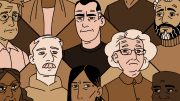NASA’s latest Discovery mission has entered orbit around the moon. The Gravity Recovery And Interior Laboratory (GRAIL) spacecraft launched from Cape Canaveral on Sept. 10, 2011, marking the start of a nine-month cycle during which the craft will make a detailed gravitational map of the moon.
The mission involves two spacecraft, GRAIL-A and GRAIL-B, each about the size of a washing machine. GRAIL-A reached its destination on Dec. 31, GRAIL-B the following day. Both GRAIL craft launched from the same rocket, the 38-metre, 282,435-kilogram Delta II.
GRAIL’s objective is to create the most detailed gravitational map of the moon to date. The mission is expected to improve our knowledge of the gravity on the near side of the moon by 100 times, and by 1,000 times on the far side. A gravitational map, used in tandem with a high-resolution topographical map, would allow scientists to infer the moon’s internal composition, yielding insights into its history and thermal evolution.
The moon preserves almost the entire 4.5 billion-year history of the solar system in its geology, and detailed knowledge of the moon’s history could reveal much about the formation of other terrestrial bodies. A map of the moon’s gravity will also serve as a navigational aid for future lunar spacecraft.
The two GRAIL spacecraft are outfitted with microwave ranging instruments that can measure the distance between them, down to a few micrometres — one micrometre is 1/1200 of the thickness of a dime. As the GRAIL craft fly over the moon, variations in gravity will affect the distance between them. This data will be recorded and used to build the gravitational map.
GRAIL is the 11th Discovery Program mission to be launched. The Discovery Program is a NASA initiative intended to complement larger, long-term “flagship” missions by launching many smaller and less costly missions in a short time. The first Discovery mission was the Near-Earth Asteroid Rendezvous (NEAR), the first space probe to orbit and land on an asteroid. Another well-known Discovery mission was the Mars Pathfinder rover, which showed that the red planet might once have been more Earth-like.
Discovery is NASA’s first program with a built-in plan for education and outreach. To aid in this, the GRAIL craft are both outfitted with MoonKAM, a four-camera imaging system that can take pictures and videos. Videos of the GRAIL launch and separation are available on the NASA website.



